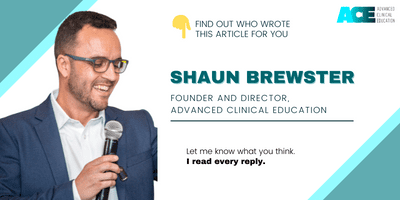A Problem well stated is a problem half solved.
In my experience, often the best and fastest way to a solution is to first get clear about the “real” goal.
I say “real” because the first stated goal or the one that seems most obvious is not always the true one.
For example, a patient may say that they have come to see you because their foot hurts when they run and they really want to get back to running… When in actual fact, for them, running is how they manage their mental health issue and that outlet for them is missing.
So their “real” goal is to manage their mental health effectively.
In a different type of example, someone may have decided to undertake further formal education to gain a higher qualification. They may say that they are doing it to further their career, when the “real” goal has more to do with finding a higher paying job and earning more money.
The problem of course is that there are plenty of highly qualified people out there who are unemployed or working in jobs that they are overqualified for.
If this person had more clearly identified their motives for study, they may instead have taken on a business mentor or sought guidance from someone who can teach them how to improve their earning capacity doing the very things they are already doing.
Charles Kettering said it best…
A problem well stated is a problem half solved.
Sakichi Toyoda, the founder of Toyota developed the 5 Why’s method. I wrote about this in another newsletter long ago, but feel that it is important enough to revisit here.
The 5 Why’s method allows suggests that when confronted with a problem that needs solving, if we ask WHY five times, the answers will efficiently take us to the real goal, issue, problem, so that we don’t waste time or energy chasing the wrong things.
Let’s apply this to the first example.
Patient: I’d like you to help fix my sore foot.
Therapist: WHY is the foot pain a problem.
Patient: It is effecting my ability to run.
Therapist: WHY is running important to you?
Patient: I enjoy running, it helps keep me fit, and it is my outlet away from work and family.
Therapist: Why do you feel running is the best way tick those boxes?
Patient: It allows me to push as hard as I feel I want to on any given day and it also lets me get out of head and blow off steam.
Therapist: Why do you feel that you need that? What happens if you don’t get a chance to do that?
Patient: I get stressed and find it hard to cope with things.
Therapist: Why do you only use running? Have you tried other forms of exercise for this purpose?
Patient: I use running because it is convenient. I do occasionally do a bit of swimming and cycling, but mostly I run.
Therapist: Ok that makes sense. While we work on your foot pain, how about we look at how we can schedule some swims and rides into your weekly routine for now, so that you still get a chance to have that outlet and stay fit, but don’t aggravate your current foot injury?
Patient: That would be great.
Work through Five Why’s and the most important factor for this patient was addressed, even before treatment had begun, and the patient helped the Therapist find the solution.
If the Therapist had only focussed on the foot injury first, the patient would likely have become frustrated with the time it may have taken to resolve the issue and compliance could have been poor.
Coming back to Charles Kettering’s quote about a problem well stated…
In all decision making processes, we should put a lot of time into really drilling down to root of the problem.
What do we REALLY want to know?
What do we REALLY need to achieve?
Why did this problem REALLY happen?
What would the best solution REALLY look like?
Try this in your next conversation with a new patient.
Try it before you make a decision to start (or stop) something.
Try it in conversations with family or friends when they come to you with a problem.
This is such a valuable change in focus, as it helps us cut through to the heart of the issue.
If you are concerned that the person you are talking to may think it is odd that you are asking WHY so many times, simply pre-empt that with a statement like “Ok, I hear you, let’s try something that I think will help me get a better understanding of what is happening here… go with me on this…”
I’d love to hear how this works for you.





